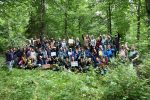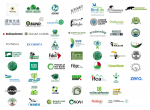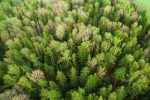by László Maráz, FUE
Firewood, paper and timber construction are already entirely using up the wood grown in Germany. The forests potential to provide renewable resources for a bioeconomy is therefore very limited if this ecosystem is not to come under further pressure.
Foto: © Eva-Maria Lopez
Forests are increasingly coming into the focus of actors who want to promote the bioeconomy. Their wood is considered one of the most important material sources to substitute fossil raw materials. An expansion of the wood production however, is limited by ecological, social and economic boundaries of the forests. Especially since forests are currently suffering from the effects of global warming already.
Paradoxically, after two years of drought in 2018 and 2019, wood is once again designated as one of the most important renewable resources for the achievement of climate goals. The German Federal Ministry of Agriculture is in fact considering making the forest fit for the bioeconomy. To substitute fossil and mineral raw materials for wood, the production of this important renewable resource, shall continue through the cultivation of supposedly more climate-friendly tree species. Instead of sparing the patient, the pressure is increased.
Ignored is the fact that the amount of wood harvested today is already used up entirely for the current main uses: Firewood, paper, wood packaging, timber construction and furniture manufacture. In the future, the building sector will use more timber for the purpose of climate protection.
Furthermore, the combustion of wood shall contribute to the saving of fossil fuels. Paper and cardboard shall increasingly replace plastics. In spite of those promises, it remains unclear where all the wood will come from!
In addition, the bioeconomy needs very specific woods for its purposes. The bioeconomic industry needs cheap raw materials to compete with petroleum-based processes. Rarely mentioned are the facts that the rising demand of wood drives up prices, and that imports from the Global South, for example, are becoming increasingly problematic. Many countries around the world want more wood for building or heating. Besides, the global destruction of forests is reducing the production area for wood. Unfortunately, the many tree planting projects change very little, since the forest area is constantly decreasing. In the wake of the climate crisis, the situation is exacerbated by drought or fires, destroying more forests.
One way out of the looming wood shortage is, same as in agricultural systems, the promotion of an increased productivity: fast-growing plantations, turbo trees, including genetic engineering methods. Again, important facts are omitted: the higher the intended yield, the higher the need of water and nutrients. The availability of both water and nutrients is short, and unused fertile land is very limited, since intensive agricultural production already occupies most of it.
For reliable prediction assessments, the dimensions of the biomass demand must be included. Even a rough estimate is sufficient to unmask the plans as pipedreams – an energy transformation based on wood is such a windmill, as long as the potential for this resource amounts to just four percent of the energy production in Germany (1). Nor can 20 million tonnes of plastics simply be substituted by wood-based materials. This aim alone would consume more than half of Germany’s total wood harvest (approx. 76 million m³/year), which, as described above, is already entirely allocated to other uses. Therefore, the amount of wood available for bioeconomy purposes, is likely a low single-digit percentage figure. As long as wood is consumed for disposable products and energy, this will remain the scenario.
(1) Wood-based potential for energy production in Germany
Further reading:
When Forests Grow Again – A Forest Vision for Climate, People and Nature
László Maráz is a forester and coordinator of the Forest Platform at the Forum Environment and Development.







